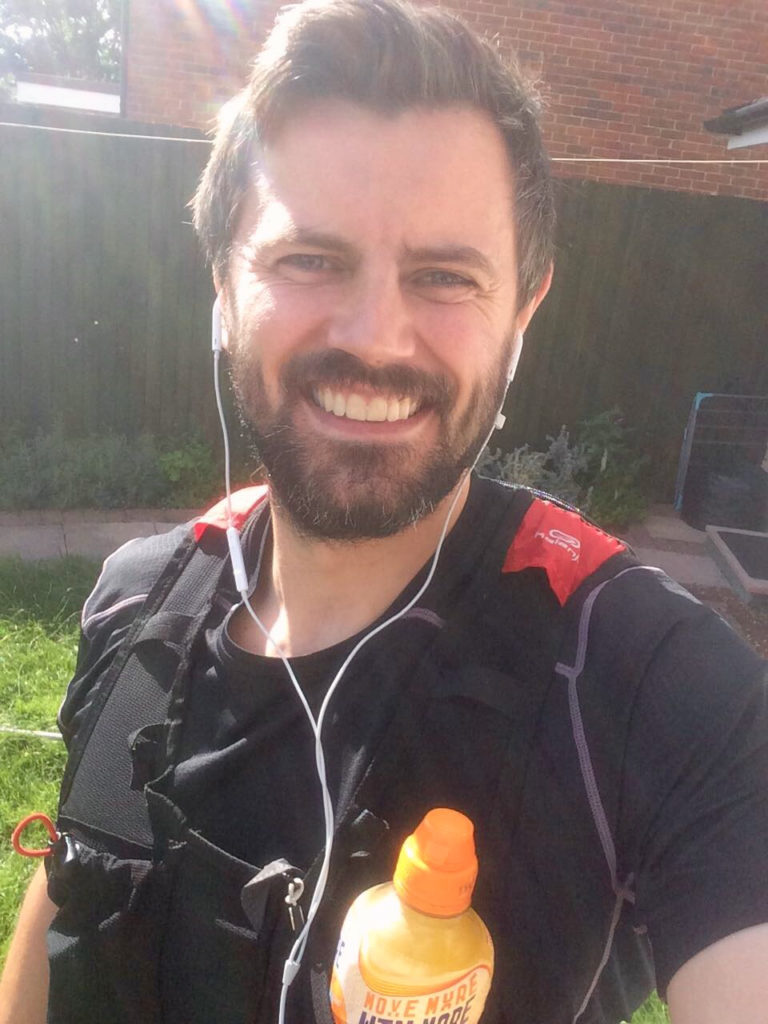
Sam’s not your typical runner…
I’m a bodybuilder by background – I lift weights until people notice that I lift weights. That’s pretty much the sport.
Running just isn’t on my agenda. It’s strictly for catching last orders at the bar or saving my small children from their latest predicament. And even then I have to give it some thought.
Bodybuilder’s stand around in small pants. It’s what we do. Bodybuilders avoid running. Always.
Which is why it made little sense to me to find myself pondering a 100K run of all things – the Thames Path Challenge, to be precise – after a coffee with a friend. My base fitness level is close to zero and, to make matters worse I had ‘allowed’ myself six weeks.
I’ve really not thought this through.
Of course, I was told it’s not possible – you’re too big, you’ll lose your gains or you’ll get seriously injured. While all potentially true, my response to this was to quote Blackadder:
“If nothing else works, a total pig-headed unwillingness to look facts in the face will see us through…”
Now, don’t for a second think I wasn’t taking this challenge seriously. I had internalised my apprehension but I knew that to be true to the cause I had to suffer. And that suffering would be the centrepiece of this whole journey.
I’d set a challenge to raise a large amount of money for charity, offered to match it via my personal training company WAKE FIT (www.wakefit.co.uk) and started to ask my nearest/dearest and amazing clients to donate.
Some large sums of money were getting handed over and that’s why my pound of miserable, suffering flesh was a necessity. I had to make this challenge hard, no, nigh on impossible, for me to justify the goal.
So now the challenge was on, the charity was in contact with me and I was ready to work to a suicidal time-frame. When pen goes to paper, running shoes go to work.
Week 1…
involved a gait analysis and some properly fitting trainers. The long and short of it is that I run atrociously. I overpronate and my arches are as flat as a pancake. I opted for some mid-foot strike trainers as a toe-strike transition would be too dangerous at that point.
And of course, the last thing you want as a runner (seems strange to refer to myself as that but anyway), is to see yourself out of action due to injury from poor planning.
Tip 1: Many people now favour a toe-strike running technique for both efficiency and injury prevention. That said, it can take people up to 18 months to safely transition from the heel.
Years of heel striking has left many runners with weakened calf muscles and achilles tendons, and the very last thing you want is an injury there.
It’s far better to progress to a mid-foot, actually achieve your running goal and then look to the toe-strike as a longer term project by perhaps following the 10% distance rule: never increase weekly mileage by more than 10% from previous week.
I left the shop with my brand new trainers which I hoped would provide a miracle, and headed home to pound the mean streets of Surrey.
Both 5K and 10K felt good, if not slightly cumbersome, and I could have sworn I started to feel the fabled runner’s high (although it turned out to be local youths in a bus stop smoking something dubious).

Giving this running malarkey a go
Week 2…
rolled around and I jumped up to 23K without too many ill effects.
By the end of the week I decided to tackle 30K and its completion in 2hrs 50mins had me relatively satisfied with my performance given my size.
In the weight training world I’m not exactly a big guy at 86kg. However, had I known how ultra-training would cure my body dysmorphia I would have done this years ago: 86kg compared to some of the racing snakes is absolutely gargantuan.
Paradoxically great for my ego, while sending me crashing back down to reality the second I see my run times.
Further down the line, when injury hit this may have been minimised by a lesser bodyweight. In my case being lighter would have made for a heavier wallet after the necessary treatments that were waiting in store for me.
Tip 2: The serious runner needs to focus on being as lean and as light as possible while still eating enough for optimal recovery and performance.
It is said that a 5kg reduction in weight can translate to 10 minutes off a marathon time.
Interspersed between these middle distances I continued stretching, short speed sessions (5K parkrun) and a variety of non-weight-bearing cardio activities such as cycling and the cross-trainer to get the lower body conditioned without over-loading my joints.
By now I had racked up the hours both on the cardio machines and the road, but not without suffering.
I had blown the ‘10% increase’ training rule straight out the water. I’d had no choice under this timeframe, my only aims were to complete the challenge and remain (largely) injury free.
Week 3…
was to be the benchmark of 50K. This was way too far to run a boring loop so I had to formulate an adventure, so a one-way run to Brighton from Surrey became the order of the day.
It was also the chance to road-test my ultra-racing backpack/vest and try to ergonomically store all the equipment I would need to sustain me through 12+ hours of running in the near future.
This turned out to be an epic-adventure. Running out of fluids and a subsequent 15-minute supermarket trip, incompetent GPS reading and a wardrobe malfunction all provided valuable learning points.
But despite all that, I made it. 50K in six hours!
Tip 3: Ultra marathon success results from many tiny decisions made correctly en-route which contributes to speed.
Do you stop to attend to that hot spot or continue and risk drastically slowing as a blister appears? Do you stop and eat or push through and save time but then lose the focus/intensity to bravely push onward? You get the picture.
Week 4…
came around I was just about recovered and back in the game.
My mantra: you may well have more talent than me but I refuse to be out-worked. So it was business as usual with a greater distance to be attempted come the weekend.
Now hindsight is a powerful tool and right here is where I should have taken a further week’s rest from a gruelling long distance.
However, I didn’t. Should I have known better? Possibly.
Tip 4: Nutrition over the longer distances takes on a whole new level.
My old self was used to chomping down on whey protein, multivitamins and in my younger days BCAAs.
Intra-workout supplements were something for the weak-minded.
Oh, how foolish I was! Try getting through 50K+ on just water and see how well it works out!
Carbs for shorter middle-distance runners will be your optimal fuel, but for those that want to hit the longer distances, as the cardiovascular intensity lowers you will find your body functions very nicely on fats.
Peanut butter and avocado on toast suit me perfectly, providing sustained energy.
As it was, 27K into my 60K run I knew that this was it. I was limping at about a 15min/K pace and knew that I was done for.
The pain in both knees and feet had gone from a mild irritation to excruciating and left me unable to step without agony.
I thought I’d felt pain squatting heavy for reps…but this was something else.
My run was over and so, I feared was my 100K challenge.
After nursing my injury and pride for the remainder of the weekend I wasted no time in booking in with the go-to physio for runners in London, Scott Newton.
Scott was very generous with both his intellect and time, and discussed a plan to get me through my race. This was music to my ears as stopping wasn’t an option.
Bodybuilding teaches you a special kind of resolve…and this is where I needed it more than ever.
I had a variety of injuries ranging from iliotibial band friction compression syndrome in the left knee, patella tendinopathy in the right knee and tibialis posterior tendinopathy in both feet.
Steroid injections were arranged where necessary (left knee) but in some areas they are considered too risky so plain old moral fibre was going to have to get me through.
Scott also looked at my running gait which as I already knew left a lot to be desired.
Tip 5: For the bigger/heavier gentleman, running efficiency takes on even more importance.
Greater efficiency equals greater speed and a reduced risk of injury. As a general rule of thumb you should be looking for a stride rate of 85-90 per minute.
Shorter, lighter steps enable you to achieve this and minimise impact forces.
To do this, straighten your body, lead with your hips and quicken your step by not striding out so far. It may well feel uncomfortable at first but with perseverance you can greatly improve your efficiency.
Despite my injuries, I was not prepared to let myself or the charity down, so I hunkered down for the long haul.
Born to Run by Christopher McDougall became my bible and inspiration was searched for high and low.
I found my saviour in Terry Fox.
He is quite possibly the most inspirational man that ever lived in my opinion (certainly within sports/athletics).
Little did I know that the suffering so far was just the warm-up act. More was to come and my challenge looked very much in the balance…
(To be continued.)
I hope you’ve enjoyed this lighthearted look at my journey so far.
It is all purely to support an amazing cause. My chosen charity was the Danny Green Fund.
It provides treatment to children suffering Posterior Fossa Syndrome which can be caused after brain tumour removal.
It has zero overheads and has been making a huge difference to children.
Please, if I’ve so much as raised a smile reading this or dropped a relevant knowledge bomb I implore you to chuck a few quid their way.
https://www.justgiving.com/fundraising/wake-fit
http://www.thedannygreenfund.org.uk/
Edited with the help of Lee Bell.






